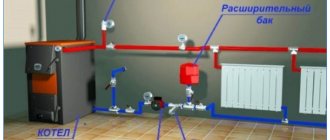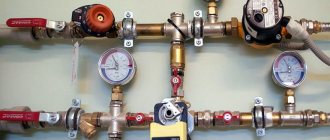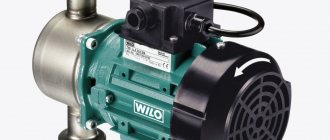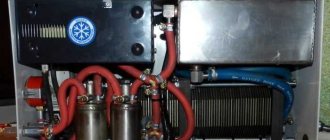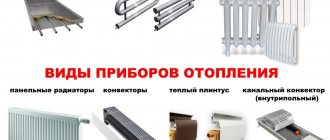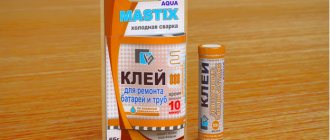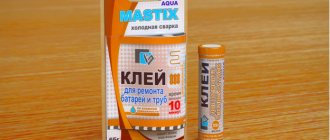In apartment buildings, one of the most common problems with the heating system is leakage of heating batteries; this happens less often in autonomous systems of private houses. Basically, depressurization occurs during hydraulic tests. Weak and worn joints cannot withstand strong pressure and begin to leak water through joints or microcracks in radiator housings.
This can happen in the most harmless situation; residents should always be prepared for such cases. People who have not encountered a similar problem immediately panic, not knowing what actions to take. First, you should place a suitable container under the flowing stream so that water does not spill onto the floor.
Where to call if the heating battery is leaking
If a person lives in an apartment building and the battery begins to leak during the heating season, the responsibility for eliminating the malfunction lies with the management company. Such a case is considered an emergency.
First of all, the resident needs to prevent the possible consequences of a leak. In order to prevent damage to the floor covering or, even worse, to avoid flooding the neighbors below, you need to find dishes to place under the leak. After this, immediately call the management company. The repair team must fix the leak in the heating battery as soon as possible and inspect the entire system in the apartment.
You can find out the phone number of the management company from your neighbors by studying the information on the walls of the entrance, in receipts, in the contract for the provision of services (for example, intercom service) or in online directories (for example, reformagkh.ru).
Effective prevention measures
Every property owner can detect a leaking pipe, regardless of the operating characteristics of the heating system. But all of the above methods of dealing with defects are relevant exclusively in the winter season, when it is necessary to take any measures as quickly as possible to restore the structure. But at the end of the heating season, it is imperative to organize professional scheduled maintenance of batteries and pipes.
The radiators are carefully dismantled and disassembled into separate sections, trying to remove all the old sealant from all threaded connections. In some cases, it may be necessary to replace old nipples. Experts definitely recommend preparing new intersectional rubber sealing gaskets. If the repairman also finds fistulas, then they must be welded in order to subsequently be able to return the already restored radiator to its place.
If the house has not previously undergone a comprehensive replacement of all components of the designed heating system, then the resulting risk of a leak increases exponentially. This is caused by natural wear and tear of communications. Experts always recommend having classic thick rubber gaskets and various clamps in your home arsenal. For emergency repairs, you will need cold welding to be able to immediately shut off the flow of moisture. In practice, it has been proven that specialized glue is capable of eliminating any leaks that form in heating devices.
Important! There is a huge range of sealants on sale that will help even an inexperienced craftsman improve the tightness of the structure. The final choice depends on the allocated budget and the actual condition of the equipment.
After all the manipulations have been done, you can install the battery in the circuit and fill the system with water to check the integrity of all connections. This stage must be performed with the boiler operating, since under the influence of pressure the circulating coolant is able to identify all weak points in the pipes. If no defects were found within 24 hours, then the problem can be considered resolved.
More interesting and educational information on this topic is presented in the video:
Average score of ratings is more than 0
Share link
Comments There are no comments yet, but you could be the first...
Reasons why depressurization occurs
Leakage problems in heating systems do not arise on their own. In each case, shortcomings are revealed that led to sad consequences.
The most common causes of leaks in the heating system:
- Exposure to external factors (impact or attempt to move the battery using force, for example, during apartment renovation).
- Manufacturing defects.
- Violation of technology during system installation.
- Radiator wear and tear over time.
- Exceeding the permissible level of water pressure in the heating system.
If the cause of depressurization is associated with an excessive increase in pressure, responsibility for the malfunction of the system lies with the management company, which is called upon to monitor the normal level of water pressure in the general heating system.
If it is possible to shut off the coolant supply to your apartment, this must be done during testing and startup of the system at the beginning of the heating season.
Damage to a piece of material that does not have a thread
You can qualitatively eliminate a leak in an operating heating radiator on your own. This is an excellent option for those situations when there is no time to wait for representatives of the housing and communal services organization, and a welding machine is also unavailable. Many deformations occur due to poor-quality welds and corrosion damage.
There are several available ways to restore the system:
- At a plumbing store, you need to buy a factory-made clamp, which is designed to combat leaks. The disassembled product is placed on the pipe so that the durable rubber gasket is located opposite the leak. At the final stage, the clamp is tightened with bolts.
- The problem can be solved with the most common aluminum clamp, which is designed to tighten hoses on fittings. First, a thick rubber gasket is applied to the current areas. The structure is clamped with a regular screwdriver. This option is distinguished by its accessibility and simplicity.
- If you don’t have time to visit stores, but you urgently need to solve the problem and eliminate the leak, then you can safely use thick copper or annealed steel wire. The product is folded in half and the gasket is pulled to the location of the detected leak in order to twist it with pliers.
Attention! If the user does not know how to cover up the formed hole, and paint streaks are clearly visible at the leak site, then the structure is first cleaned with a knife. The performer of such painstaking repair manipulations should be prepared for the fact that after the completed manipulations, the liquid pressure will increase slightly.
An accessible way to unscrew the plug
Cases in which you can fix a pressure leak without draining the water
If a minor water leak occurs in a private home, you should use one of the appropriate methods to eliminate the leak without draining the water and reducing the pressure. The same applies to an apartment, if the accident does not cause difficulties.
Before you get to work, you need to make sure that the water in the radiator is not very hot. Otherwise, you may suffer serious burns.
No special equipment is required to eliminate minor accidents. The most suitable chemical materials that can stop leaks include various sealants used in automobile engine repair (BBF Super, Liqui Moly Kuhler Dichter). They are able to withstand high temperatures and withstand high pressure. A leak in a straight pipe should be stopped using sealant in the following order:
- Apply sealant to durable cloth.
- Wrap the fabric tightly around the pipe.
- Secure the bandage with clamps, wire or rope.
Wider clamps can also be used, but they are harder to find.
At high temperatures, the sealant hardens quickly and retains its properties for a long time even at high water pressure. In addition to sealants, compositions based on epoxy resin are used to eliminate leaks.
If a metal pipe is leaking, it is customary to use rubber-based materials. Such compositions are also able to withstand high temperatures and are used to seal leaks without draining the liquid. This is done as follows:
- The pipe is wrapped with serpyanka.
- A rubber compound is applied to the winding.
Serpyanka is an adhesive reinforcing tape.
Such methods of eliminating leaks are effective only in cases where the liquid only drips. If the problem is more serious, you will have to resort to mechanical methods. They are able to completely eliminate water leakage under pressure. However, all these methods are used only as temporary ones.
Effective mechanical methods include a crimping device and installing a self-tapping screw if there is a hole at the leak site.
The crimping device is very simple to make:
- Take a rubber band.
- The leak area is tightly wrapped with rubber.
- The winding is fixed with a clamp or wire.
A metal self-tapping screw with a rubber gasket under the head is suitable for sealing the hole. You can tighten the hardware with a wrench, pliers or a screwdriver.
DIY repair
All proposed measures are temporary. At the first opportunity, you should invite a specialist who will repair the defect, or better yet, replace the heating device or rusted pipe.
First you need to determine where the coolant is leaking from. These can be sections, connections between them, joints between radiators and pipes, and the pipes themselves. Then carry out repairs using one of the methods described below.
How to repair a crack in a battery
Clean the damaged area from paint and rust. To do this, you can use grinding devices, solvents and anti-rust liquids. Be sure to make a small allowance, capturing adjacent areas. Clean the cleaned metal surface with sandpaper or a stiff brush.
Fill the defect with metal epoxy resin, which sets in just five minutes. Cold welding is also suitable - but then you will have to wait 2-3 hours for drying.
Plug small defects with a wooden wedge plug. Drill out the fistula a little into sections and hammer the plug into the resulting hole. The wood will swell with liquid and the battery will become sealed.
How to fix a leak between two sections
Clean any paint or rust from the metal in the damaged area. Prepare the epoxy resin as directed in the instructions and apply it to the defect. You can cover the leak area with cold welding or wrap it with a cloth moistened with moisture-resistant heat-resistant glue. Turn on the batteries only after the patch has completely dried.
Leak where the radiator connects to the pipe
Inside such a joint there is a sealant - flax tow or fum tape, which lose their properties over time. To restore the joint's tightness, the sealing material must be replaced.
Take a wrench and unscrew the connection with it. Remove the old seal and replace it with a new one. You can use flax tow, lubricated with plumbing sealant, or fum tape. Then screw everything back on.
If the breakdown is caused by corrosion at the joint, you will not be able to correct the situation yourself. You need to call a technician who will repair the defect or replace rusted elements.
What to do if a pipe is leaking
The leak can be sealed with plumbing rubber and a clamp. If you don't have any, take a piece of bicycle tire, wrap it around the pipe and tighten it with wire. The water will stop running onto the floor.
You can cover up the defect by cold welding, working on a wet surface. It is necessary to clean the metal in the place of damage from paint, rust and seal the leak. After the weld hardens, the pipe will become airtight again.
If the Mayevsky tap is leaking
This part is used in heating radiators as air valves. Over time, the rubber gasket becomes unusable and the faucet begins to leak water. Ideally, it is better to replace the damaged gasket with a new mechanism. If there is no spare part, a special product called “Santech Master Gel” will come to the rescue. It has detailed instructions for use. Based on the recommendation, you should do the following:
- Unscrew the tap and remove the rubber gasket.
- Liberally lubricate the threads on the tap with gel.
- Apply the product to the rubber seat.
- Lubricate the initial threads on the battery.
- Install the tap, unscrew halfway and tighten completely.
- Wipe off any remaining gel from the surface.
- Wait 15 minutes and check the operation of the tap.
Instructions for Santech Master Gel sealant (click to enlarge).
Fighting cracks of different diameters
Elimination of such defects has its own characteristics. The most suitable option is to use traditional welding. But this option is quite labor-intensive, and also implies the presence of appropriate equipment and minimal skills. As an excellent alternative, you can use special glue. First, the technician needs to prepare the problem area of the battery. The process itself is based on cleaning the surface and degreasing it.
The prepared cold weld fragment is pressed against the crack formed with a certain force. This material stands out for its quality and reliability, since it polymerizes within a few minutes. It takes 35-45 minutes for the formed seam to harden. The very next day, the restored battery can be put into operation, but after the end of the heating season, such a device will need to be replaced, since such welding falls into the category of temporary repair work.
Rewinding the cork for better sealing
Leak between two battery sections
Cast iron batteries are considered the most popular. But they are often the culprits of leaks. This usually happens at the points where sections connect to each other. During operation of the heating system, it can be difficult to determine the location of the leak, since the battery gets completely wet. In this case, you have to shut off the water supply. To identify the location of the leak, you need to wipe the battery dry.
If there is a leak between sections, cold welding is used. It is based on epoxy glue and metal powder; the product is sold in small tubes. Before using welding, the leak site must be thoroughly cleaned of all excess impurities, treated with sandpaper and degreased. As a rule, any such product is supplied with instructions for use.
Algorithm for applying cold welding (click to enlarge).
Some of them are not suitable for use with water. Welding can be liquid, and more often in the form of plasticine. Its two components need to be kneaded in your hands until a homogeneous mass is obtained. The finished weld is applied to the joint where there is a leak. Complete polymerization is expected only after a few hours.
The use of rubber gaskets and conventional clamps
Before repairing bimetallic heating radiators, you should prepare some materials and equipment:
- Pliers.
- Aluminum clamps.
- Wire.
- Classic gasket made of durable rubber.
The repair technology includes a certain list of important stages. A gasket is placed in place of the leak and everything is secured with a clamp. If you don’t have the right tools at home, then a simple wire and a bicycle tube will do just fine. From this material you can carefully cut a piece of rubber of the appropriate size. You can secure the homemade gasket with strong wire. To achieve a good tie, you need to use pliers.
Leaking from the connection between the radiator and pipes
Most often in this case, problems arise with the seal on the thread. Troubleshooting will require shutting off the water and reducing the pressure.
For such cases, it is advisable to keep spare nuts and couplings at home. The old ones could become unusable. Rusted parts do not always withstand the stress of working with them. In cases of thread damage, a die will be needed. When everything is ready, tow is wound onto the threads and a layer of Unipak paste is applied on top. The parts are tightly screwed. Gradually opening the water supply tap, the reliability of the work done is checked.
Instructions for sealing a threaded connection with tow and sealing paste (click to enlarge).
Scheduled Maintenance
All of the above methods are mostly used in winter, when something urgently needs to be done. During the warm period of the year, you can carry out scheduled maintenance of risers and batteries so that leaks do not occur in winter. The battery is completely removed from its place and unrolled into sections. All threaded connections are cleaned of old sealant. If necessary, nipples are replaced with new ones. Intersectional gaskets are also completely replaceable. The detected fistulas are welded or sealed, and the battery is installed in its place. In the video below you can see other ways to eliminate leaks.
Depressurization of the radiator wall or fin
This kind of damage brings big trouble. It is extremely difficult to fix a problem when the battery is leaking, but for a short time you can find a way out of the situation. The method is quite simple.
The small hole on the battery needs to be enlarged. Before doing this, you need to turn off the water and reduce the pressure. Using a drill, make a hole larger than it was. A wooden peg is inserted into the drilled hole. When exposed to water, it swells and stops water leakage.
You can also use a self-tapping screw with a rubber washer instead of a peg.
Of course, leaving the battery in this state for a long time is dangerous; the section must be urgently replaced with a new one.
Temporary solution
So, if water runs in a thin stream from any place in your radiator, and you do not have the opportunity to stop the flow of coolant, then you can try to block the damaged area in such a way as to prevent further troubles. To do this, you will need something rubber: for example, an old rubber boot, an inner tube from a bicycle or car wheel, a household or medical glove - in general, anything as long as it is made of rubber.
The algorithm of actions is simple.
- Cut the rubber product into strips. The longer they are, the better. The width of each strip should be such that the leak can be completely covered.
- Now you need to wrap the damaged area with the resulting strips. Start the process near the place where the water is flowing, gradually moving towards it. The turns should overlap each other slightly. It is necessary to wind the rubber as tightly as possible - the tighter the fit of the strips, the more reliable the effect will be.
- After the winding is done, it needs to be fixed. To do this, make a tie using a fabric tourniquet - it must be placed over the leaking area. Instead of fabric, you can use strong wire, but it must be wound in the same way as rubber, in turns across the entire width of the original winding. A car clamp is also suitable - this is generally quite a useful thing that can be useful on the farm many times, so it is recommended to purchase more of them for the future. Another option for securing the patch is a strip of tin. It can be tightened over the rubber using bolts.
Of course, such a solution is only temporary. Ideally, after eliminating the leak in this way, it is still advisable to call the emergency service so as not to risk it. But in many cases, such a rubber patch helps you survive until the end of the heating season, and then you can safely do more general repairs or replace the battery.
You can make your life even easier if you purchase special plumbing clamps to eliminate such troubles. They are designed specifically for pipe repair. Such a clamp is a metal product with rubber attached to the inner wall. That is, in essence, this is the same patch described above, but its application is much more convenient - fixing the leak will take about a minute.
If this solution does not work, and the coolant still continues to leak from under the patch, then you still need to either call an emergency team, or, if possible, stop the heating system yourself and begin serious repairs. There are several ways to eliminate a leak. The simplest of them is gluing.
This is interesting: How to choose bathroom furniture
Liquid sealants to eliminate leaks in the heating system
Liquid sealant is designed to eliminate water leaks. It is better suited for repairing heating systems. The liquid product can cover hidden damage from the inside. This applies, first of all, to pipes that can be walled up in the wall or located under the floor. The sealant is poured into the pipe, it penetrates the problem area and fills it.
How to choose
There are various types of sealants available on the market. They are designed for use in different situations, which makes the problem of choice much more difficult. To avoid mistakes, you should familiarize yourself with the characteristics of a particular type of sealing agent. The product for use in heating systems must meet the following requirements:
- high level of temperature resistance;
- resistance to moisture;
- endurance to temperature changes in the system;
- resistance to mechanical influences that can deform parts.
Depending on the scope of application, sealants differ in composition and are divided into the following types:
- For external use . It is applied to the leak site and eliminates the problem as it hardens.
- For indoor use . Liquid sealant is poured into the system, finds the leak and eliminates the leak.
- For compaction . Used to strengthen joints in heating systems.
All this information is on the packaging. It must be read carefully.
We select fasteners for heating radiators Selection criteria, calculation of the required quantity, marking and installation
Based on their composition, the products are divided into three types:
- Silicone.
- Based on acrylic glue.
- From rubber and aerobes.
Acrylic sealant is not suitable for heating systems. It instantly hardens, becoming rocky. Having lost elasticity, the product is destroyed. Rubber and silicone based sealants are ideal. If the product is manufactured for use in automobile engines, it can be safely used in heating systems.
Important: To seal heating systems, you should choose a product based on neutral silicone. The acid content leads to aggressive reactions with the metal.
The choice of sealant also depends on the place to be repaired. A paste-like product is more suitable for joints; it is produced in two versions:
- Drying sealant . After application, it hardens quickly if the drying technology is not followed. The hardened composition is deformed and covered with cracks.
- Non-drying sealant . Ideal for filling small holes and sealing joints. This product has one drawback: it can be squeezed out as a result of exceeding normal pressure levels.
Aerobic sealant is a type of acrylic analogue. It is sometimes used to repair leaks and minor defects. It can withstand high temperatures and is resistant to acids and alkalis. The sealant quickly fills the area of depressurization and dries just as quickly.
For internal use, sealants are divided into 3 types according to the following characteristics:
- Mixtures where the coolant is water or antifreeze.
- Compositions for system joints.
- Sealants for boilers operating on gas or solid fuel.
Liquid products from German manufacturers are popular. These compounds provide reliable sealing of equipment and boilers.
The best and most famous remedies
| Name | Photo | Description | Price |
| AQUASTOP | High-quality sealant based on rubber. Has a wide range of applications. The unique formula with fibers seals instantly even in extreme conditions. | 3 liters 11,500 rub. | |
| HeatGuardex BLOCKSEAL 100 HD | Self-regulating agent for sealing leaks in heating systems. Effective in eliminating leaks in hard-to-reach places from the inside. Suitable for sealing gas boilers. | 1 liter 4,700 rub. | |
| BCG | German-made liquid sealant is ideal for sealing leaks in heating systems from the inside. | 1 liter 3,450 rub. |
Instructions for use
Before you pour sealant into the system, you need to know the volume of water in this system. To accurately and conveniently determine the amount of liquid, it is better to completely drain it into a container whose volume is known. To eliminate possible leaks in the future, it is advisable to regularly fill the system with sealant.
Important: for the sealant to effectively act on the damaged area, it is necessary to correctly determine the appropriate concentration of the product. For 80 liters of water, 1 liter of mixture is enough.
Before pouring sealant, you need to bleed the air from the system. Otherwise, under pressure, the product will not only clog the defective area, but will also cause the circulation of the coolant to stop.
For good sealant passage through the system, all taps must be opened. On the first radiator, unscrew it completely. After completing the process, you need to connect the pump, bring the temperature in the system to 60 degrees and create a pressure of 20 bar.
For quick filling, you can use a regular inexpensive “Malysh” type pump.
Before pouring liquid sealant, you need to remove the mechanical cleaning filters. Under the influence of the product they will fail. Fill the liquid as follows:
- Take 1.5 buckets of heated water, shake the product, add to the buckets and quickly pump into the system.
- Remove air to allow mixture to circulate through the system.
Complete sealing of the system takes about 3 days. After this time, the pressure should be increased to check the result.
Types of leaks
Heat supply to the premises is carried out using pipes and heat removal devices. The working medium is supplied through risers, from which distribution is made to apartments. Depending on the current situation, each module may leak.
Main causes of malfunction:
- fistula in the section of the heat-transfer device;
- leakage at the junction of the radiator and the pipe;
- intersectional leakage;
- depressurization of a pipe seam;
- valve leaked;
- leakage in the area where the branch connects to the riser.
Each malfunction requires an individual approach and its own repair method.
Correct check of radiators before the heating season
Battery checks should be carried out in the summer. Immediately after the heating season, it is recommended to perform pressure testing. To do this, increase the hydraulic pressure in order to identify weak points. If leaks are detected, they are repaired.
Checking radiators should consist of several stages:
- Thorough external cleaning of radiators . Dirty batteries weaken the system and cause unpleasant odors. In addition, uncleaned batteries can become sources of harmful microorganisms that can bring illness into the home. When servicing equipment, detergents should be used.
- Cleaning the batteries inside . To do this, you can use dust brushes with a long handle. You can buy periscopic devices on the market to get to the most inconvenient corners. It is advisable to carry out internal cleaning at least every 5-7 years.
- Adding water . When the radiators are already clean, you can begin ventilating the heating equipment. During downtime, a large number of air pockets could appear that block water circulation. The air should be completely expelled from the system.
Poll: Do you carry out annual inspection and pressure testing of your heating system?
Battery leaks in heating systems occur quite often. You always need to be prepared for this. Scheduled maintenance of the heating system guarantees uninterrupted operation for a long time. But it’s still better to always play it safe and keep the necessary tools and supplies at home in case of breakthroughs. The equipment must be monitored at all times to avoid unpleasant consequences.
Universal hermetic seal
Leaks often occur in an aluminum radiator, which are directly related to various unfavorable operating parameters. To restore the integrity of the structure, a high-quality sealant can be used, which can be purchased at any hardware store. The product that manufacturers produce specifically for heating radiators, consisting of polymers or a special powder, has proven itself to be excellent.
Attention! Due to its specific composition, upon contact with air, the sealant simply polymerizes.
After complete hardening, the applied composition perfectly eliminates leaks, so you can avoid large financial investments in major repairs. If the homeowner has previously worked with sealants, he can quickly take emergency measures so that the system can continue to heat the house.
